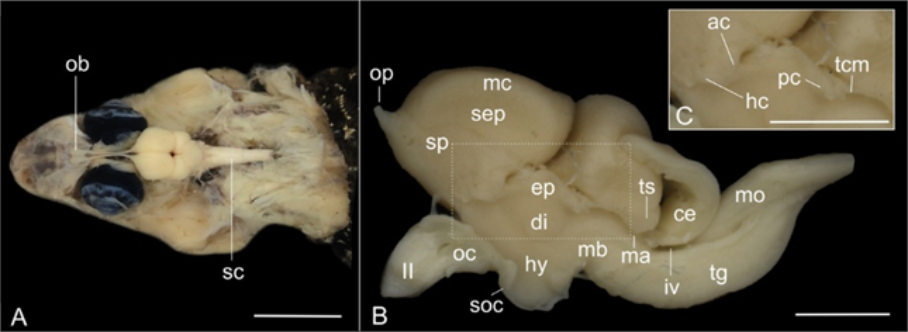Anatomia macro- e microscópica do encéfalo do calango (Tropidurus torquatus) (WIED, 1820)
DOI:
https://doi.org/10.1590/1809-6891v24e-74091EResumo
Os répteis têm um papel fundamental para a compreensão da independência reprodutiva da água que surgiu nos amniotas. Várias adaptações ocorreram, inclusive em padrões e comportamentos locomotores, e o sistema nervoso se adaptou a esses novos hábitos. Descrevemos a anatomia macroscópica e a citoarquitetura do encéfalo do calango (Tropidurus torquatus), um lagarto abundante na América do Sul. Quinze espécimes foram capturados, eutanasiados e seus encéfalos dissecados, oito destes foram processados e corados em hematoxilina-eosina. As principais áreas do cérebro são o telencéfalo e o diencéfalo, na parte anterior do encéfalo, teto e tegmento, no mesencéfalo e bulbo e cerebelo, na parte posterior do encéfalo. Os bulbos olfatórios principais e acessórios são as estruturas mais rostrais do cérebro e são compostos por seis camadas. Os hemisférios cerebrais compõem o telencéfalo e são divididos em pálio e subpálio. Os córtices medial, dorsomedial, lateral e dorsal fazem parte do pálio. Estriado, pálido e septo compõem o subpálio. O diencéfalo é composto pelo tálamo, epitálamo e hipotálamo. O mesencéfalo possui um tegmento ventral, composto de torus semicircularis e um tecto óptico dorsal com 14 camadas. A maior parte da parte posterior do encéfalo é composta pelo bulbo, e o cerebelo surge como uma projeção dessa estrutura, em formato plano, com três camadas. Em geral, o encéfalo de Tropidurus torquatus se assemelha ao de outros lagartos, com suas próprias adaptações.
Palavras-chave: histologia; lagarto; morfologia; réptil; sistema nervoso.
Downloads
Referências
Shedlock AM, Edwards SV. Amniotes (amniota). In: Hedges SB, Kumar S (eds.). The timetree of life. Oxford: Oxford University Press; 2009. p. 375-379.
Naumann RK, Ondracek JM, Reiter S, Shein-Idelson M, Tosches MA, Yamawaki TM, Laurent G. The reptilian brain. Current Biology. 2015;25(8):R317-R321.
Kiefer MC, Van Sluys M, Rocha CF. Body temperatures of Tropidurus torquatus (Squamata, Tropiduridae) from coastal populations: Do body temperatures vary along their geographic range? Journal of Thermal Biology. 2005;30:449-456.
Siqueira CDC, Kiefer MC, Sluys MV, Rocha CFD. Plant consumption in coastal populations of the lizard Tropidurus torquatus (Reptilia: Squamata: Tropiduridae): how do herbivory rates vary along their geographic range? Journal of Natural History. 2010;45:171-182.
Ortiz MA, Boretto JM, Piantoni C, Álvarez BB, Ibargüengoytía NR. Reproductive biology of the Amazon Lava Lizard (Tropidurus torquatus) from the Wet Chaco of Corrientes (Argentina): congeneric comparisons of ecotypic and interspecific variations. Canadian Journal of Zoology. 2014;92:643-655.
Py‐Daniel TR, De‐Lima AKS, Lima FC, Pic‐Taylor A, Rodrigues RPJ, Sebben A. A Staging Table of Post‐Ovipositional Development for the South American Collared Lizard Tropidurus torquatus (Squamata: Tropiduridae). The Anatomical Record. 2017;300:277-290.
Hoops D. A perfusion protocol for lizards, including a method for brain removal. MethodsX. 2015;2:165-173.
Wright KP, et al. E. In: Binder MD, Hirokawa N, Windhorst U. (eds.) Encyclopedia of Neuroscience. Berlin: Springer; 2008. p. 1029-1548.
World Association of Veterinary Anatomists. Nomina anatomica veterinaria. 6th ed. Columbia: International Committee on Veterinary Gross Anatomical Nomenclature; 2017. 160 p.
Senn DG. Embryonic development of the central nervous system. In: Gans C (ed.). Biology of the Reptilia, Volume 9. Neurology A. London: Academic Press; 1979. p. 173-244.
Reis LTMD. Estudo morfológico do encéfalo de répteis (Chordata: Reptilia) (Doctoral dissertation). Uberlândia: Universidade Federal de Uberlândia. 2017.
Armstrong JA, Gamble HJ, Goldby F. Observations on the olfactory apparatus and the telencephalon of Anolis, a microsmatic lizard. Journal of anatomy. 1953;87:288-307.
Northcutt RG. Architectonic studies of the telencephalon of Iguana iguana. Journal of Comparative Neurology. 1967;130:109-147.
Llahi S, García‐Verdugo JM. Neuronal organization of the accessory olfactory bulb of the lizard Podarcis hispanica: Golgi study. Journal of Morphology. 1989;202:13-28.
Cruce JAF. A cytoarchitectonic study of the diencephalon of the tegu lizard, Tupinambis nigropunctatus. Journal of Comparative Neurology. 1974;153:215-238.
Curwen AO. The telencephalon of Tupinambis nigropunctatus. I. Medial and cortical areas. Journal of Comparative Neurology. 1937;66:375-404.
Shanklin WM. The central nervous system of Chameleon vulgaris. Acta zoologica. 1930;11:425-490.
Smeets WJ, Hoogland PV, Lohman AH. A forebrain atlas of the lizard Gekko gecko. Journal of Comparative Neurology. 1986;254:1-19.
Hoops D, et al. A 3D MRI‐based atlas of a lizard brain. Journal of Comparative Neurology. 2018;526(16):2511-2547.
Lohman AHM, Van Woerden-Verkley I. Further studies on the cortical connections of the Tegu lizard. Brain research. 1976;103:9-28.
Bruce LL, Butler AB. Telencephalic connections in lizards. I. Projections to cortex. Journal of Comparative Neurology. 1984;229:585-601.
Butler AB. Telencephalon of the lizard Gekko gecko (Linnaeus): some connections of the cortex and dorsal ventricular ridge. Brain, Behavior and Evolution. 1976;13:396-417.
Lohman AHM, Mentink GM. Some cortical connections of the tegu lizard (Tupinambis teguixin). Brain research. 1972;45:325-344.
Browner RH, Rubinson K. The cytoarchitecture of the torus semicircularis in the Tegu lizard, Tupinambis nigropunctatus. Journal of Comparative Neurology. 1977;176:539-557.
Díaz C, Yanes C, Trujillo CM, Puelles L. Cytoarchitectonic subdivisions in the subtectal midbrain of the lizard Gallotia galloti. Journal of Neurocytology. 2000;29:569-593.
Butler AB, Ebbesson SO. A Golgi study of the optic tectum of the Tegu lizard, Tupinambis nigropunctatus. Journal of Morphology. 1975;146:215-227.
Foster RE, Hall WC. The connections and laminar organization of the optic tectum in a reptile (Iguana iguana). Journal of Comparative Neurology. 1975;163:397-425.
Huber G, Crosby EC. The reptilian optic tectum. Journal of Comparative Neurology. 1933;57:57-163.
Larsell O. The cerebellum of reptiles: lizards and snake. Journal of Comparative Neurology. 1926;41:59-94.

Downloads
Publicado
Como Citar
Edição
Seção
Licença
Copyright (c) 2023 Ciência Animal Brasileira / Brazilian Animal Science

Este trabalho está licenciado sob uma licença Creative Commons Attribution 4.0 International License.
Autores que publicam nesta revista concordam com os seguintes termos:
- Autores mantém os direitos autorais e concedem à revista o direito de primeira publicação, com o trabalho simultaneamente licenciado sob a Licença Creative Commons Attribution que permite o compartilhamento do trabalho com reconhecimento da autoria e publicação inicial nesta revista.
- Autores têm autorização para assumir contratos adicionais separadamente, para distribuição não-exclusiva da versão do trabalho publicada nesta revista (ex.: publicar em repositório institucional ou como capítulo de livro), com reconhecimento de autoria e publicação inicial nesta revista.
- Autores têm permissão e são estimulados a publicar e distribuir seu trabalho online (ex.: em repositórios institucionais ou na sua página pessoal) a qualquer ponto antes ou durante o processo editorial, já que isso pode gerar alterações produtivas, bem como aumentar o impacto e a citação do trabalho publicado (Veja O Efeito do Acesso Livre).






























